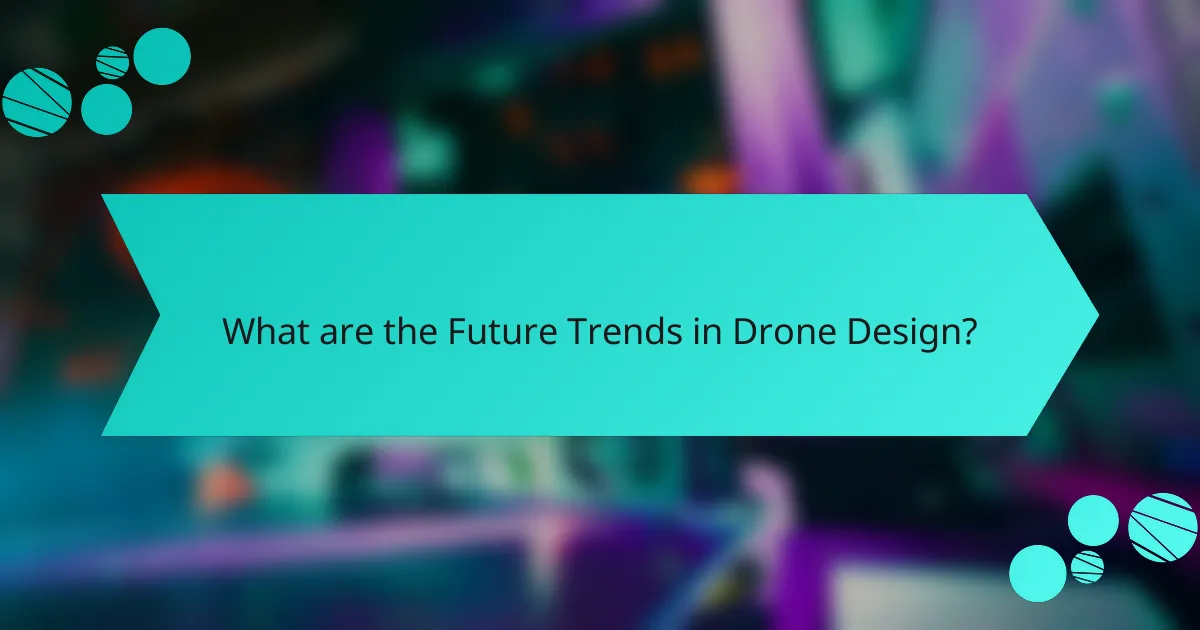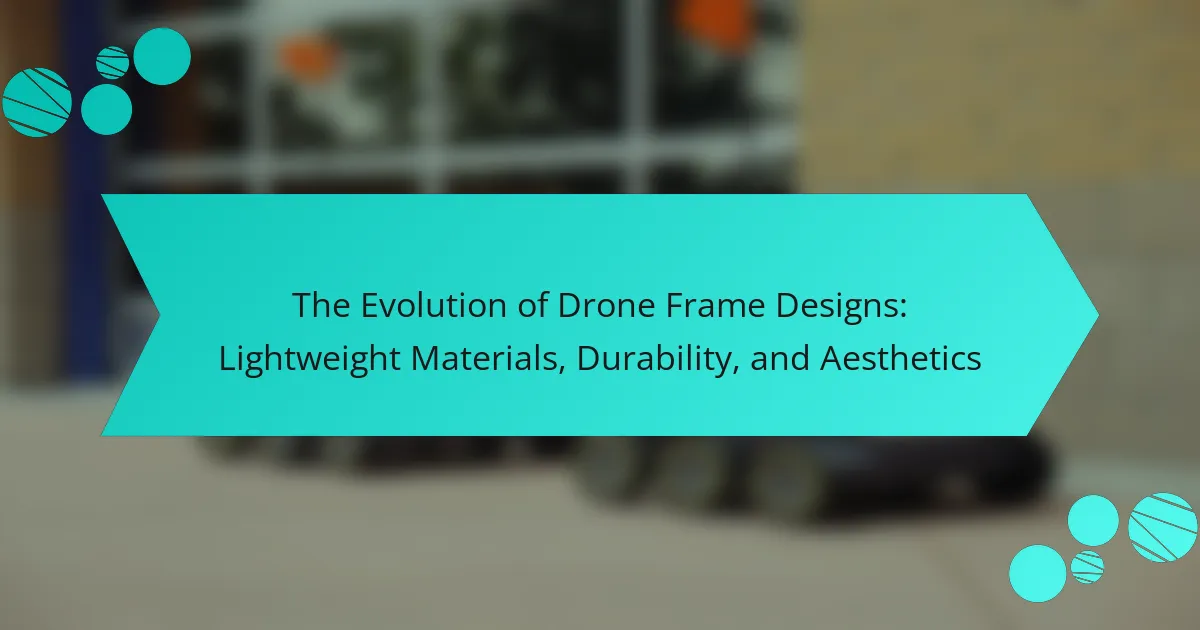
What are the Future Trends in Drone Design?
Future trends in drone design include sustainable materials, smart technology integration, and user-centric features. Sustainable materials, such as biodegradable composites, are being developed to reduce environmental impact. Smart technology integration focuses on AI and machine learning for enhanced navigation and obstacle avoidance. User-centric features are evolving to improve usability, including intuitive controls and customizable interfaces. These trends align with increasing demand for eco-friendly and efficient drone solutions. Research indicates that the global drone market is projected to grow significantly, driving innovation in these areas.
How are sustainable materials influencing drone design?
Sustainable materials are significantly influencing drone design by promoting eco-friendliness and reducing environmental impact. Manufacturers are increasingly using biodegradable composites and recycled plastics in drone construction. This shift helps lower carbon footprints during production and disposal. For example, companies like Boeing have explored bio-based materials for lightweight structures. Additionally, sustainable materials often enhance durability and performance, leading to longer-lasting drones. Research indicates that drones made from these materials can also improve energy efficiency. As the industry evolves, the integration of sustainable materials is becoming a standard practice in drone development.
What types of sustainable materials are being utilized in drone manufacturing?
Biocomposites and recycled plastics are being utilized in drone manufacturing. Biocomposites are made from natural fibers and polymers. They reduce environmental impact compared to traditional materials. Recycled plastics come from post-consumer waste, minimizing landfill contributions. Additionally, metals like aluminum are often recycled in drone construction. These materials offer lightweight properties, enhancing flight efficiency. The use of sustainable materials aligns with growing environmental regulations in manufacturing. This shift is supported by industry trends towards eco-friendly practices.
How do sustainable materials impact the performance of drones?
Sustainable materials enhance the performance of drones by reducing weight and improving durability. Lighter drones can achieve longer flight times and better energy efficiency. Materials like carbon fiber and bioplastics offer high strength-to-weight ratios. These materials also contribute to environmental sustainability, aligning with industry trends. Research shows that drones made from sustainable materials can perform similarly or better than traditional materials. For example, a study by the University of Cambridge found that carbon fiber composites increased drone efficiency by 15%. This efficiency leads to lower operational costs and reduced environmental impact.
What role does smart technology integration play in drone innovation?
Smart technology integration is crucial for drone innovation. It enhances operational efficiency and expands functionality. Advanced sensors and AI algorithms enable real-time data processing. This allows drones to navigate complex environments autonomously. Smart technology also improves communication systems for better coordination. According to a report by MarketsandMarkets, the drone services market is expected to grow significantly due to such integrations. The use of smart technology leads to increased safety and reliability in drone operations. This integration is essential for applications in various sectors, including agriculture, logistics, and surveillance.
What are the latest advancements in smart technology for drones?
The latest advancements in smart technology for drones include enhanced AI algorithms, improved obstacle avoidance systems, and real-time data processing capabilities. AI algorithms enable drones to learn from their environments and adapt their flight paths. Advanced obstacle avoidance systems utilize LiDAR and computer vision for safer navigation. Real-time data processing allows drones to analyze and respond to environmental changes instantly. These technologies improve operational efficiency and safety. For instance, the integration of AI has been shown to reduce collision rates by up to 60% in various studies. Additionally, companies like DJI and Skydio are leading these innovations, pushing the boundaries of drone capabilities.
How does smart technology enhance drone functionality and efficiency?
Smart technology enhances drone functionality and efficiency by enabling advanced automation and real-time data processing. Drones equipped with smart sensors can detect obstacles and adjust flight paths autonomously. This reduces the risk of collisions and improves safety. Smart algorithms optimize flight routes, resulting in time and energy savings. For instance, drones can analyze weather conditions and adjust their operations accordingly. Furthermore, machine learning allows drones to learn from past flights, improving their performance over time. Real-time data analytics also enables better decision-making for applications like delivery and surveillance. Overall, the integration of smart technology significantly boosts the operational capabilities of drones.
Why are user-centric features becoming essential in drone design?
User-centric features are becoming essential in drone design to enhance user experience and operational efficiency. As the drone market expands, user demands for intuitive interfaces and personalized functionalities increase. These features improve accessibility for various users, including hobbyists and professionals. Research shows that drones with user-centric designs lead to higher satisfaction rates. For instance, a study by the Federal Aviation Administration indicates that user-friendly controls reduce the learning curve for new operators. Furthermore, integrating feedback mechanisms allows for continuous improvement based on user input. This trend reflects a broader shift towards prioritizing user needs in technology development.
What are the key user-centric features being developed for drones?
Key user-centric features being developed for drones include enhanced safety systems, user-friendly interfaces, and improved autonomy. Enhanced safety systems involve obstacle detection and collision avoidance technologies. These systems utilize sensors and algorithms to prevent accidents during operation. User-friendly interfaces focus on intuitive controls and real-time feedback for users. This makes drones easier to operate for both novices and experienced pilots. Improved autonomy allows drones to perform tasks with minimal human intervention. This includes automated flight planning and execution. Such features are supported by advancements in artificial intelligence and machine learning. These developments enhance the overall user experience and operational efficiency of drones.
How do user-centric features improve the overall user experience with drones?
User-centric features significantly enhance the overall user experience with drones. These features prioritize the needs and preferences of users, making drones more accessible and easier to operate. For instance, intuitive control interfaces simplify navigation for beginners. Customizable settings allow users to tailor flight modes to their skill levels. Additionally, real-time feedback systems provide critical information, improving situational awareness. Safety features, such as obstacle detection, reduce the risk of accidents. User-friendly designs promote longer usage times and satisfaction. Collectively, these attributes lead to increased engagement and wider adoption of drone technology.
How do sustainable materials, smart technology, and user-centric features interconnect in drone design?
Sustainable materials, smart technology, and user-centric features interconnect in drone design by enhancing performance and environmental responsibility. Sustainable materials reduce the overall carbon footprint of drones. These materials often include lightweight composites that improve energy efficiency. Smart technology enables real-time data analysis and autonomous navigation. This technology enhances the drone’s operational capabilities and reduces user intervention. User-centric features focus on improving the user experience through intuitive controls and customizable settings. Together, these elements create drones that are efficient, environmentally friendly, and user-friendly, meeting the demands of modern applications.
What challenges are faced in the integration of these trends in drone design?
The integration of trends in drone design faces several challenges. Sustainable materials often lack the strength and durability of traditional options. This can limit the performance and lifespan of drones. Smart technology integration requires advanced software and hardware compatibility. Ensuring seamless communication between components is complex. User-centric features demand extensive user research and testing. This can increase development time and costs. Regulatory compliance is another significant hurdle. New technologies must meet safety and operational standards. Additionally, the rapid pace of technological change can lead to obsolescence. Keeping up with trends while ensuring reliability is a constant challenge.
What best practices should manufacturers follow when adopting future trends in drone design?
Manufacturers should prioritize sustainable materials in drone design. Using eco-friendly materials reduces environmental impact. They should also integrate smart technologies for enhanced functionality. Smart sensors and AI can improve navigation and safety. User-centric features must be developed based on consumer feedback. This ensures the product meets market needs effectively. Manufacturers should stay updated on regulatory changes. Compliance with aviation laws is crucial for market entry. Continuous testing and iteration enhance product reliability. These practices lead to innovative and competitive drone designs.
The main entity of this article is drone design, focusing on future trends such as sustainable materials, smart technology integration, and user-centric features. Key discussions include the impact of biodegradable composites and recycled plastics on environmental sustainability, advancements in AI and automation for improved drone functionality, and the importance of intuitive interfaces for enhancing user experience. The article also addresses the interconnection of these trends, the challenges faced in their integration, and best practices for manufacturers to adopt these innovations effectively. Overall, it provides a comprehensive overview of how these elements are shaping the future of drone technology.



